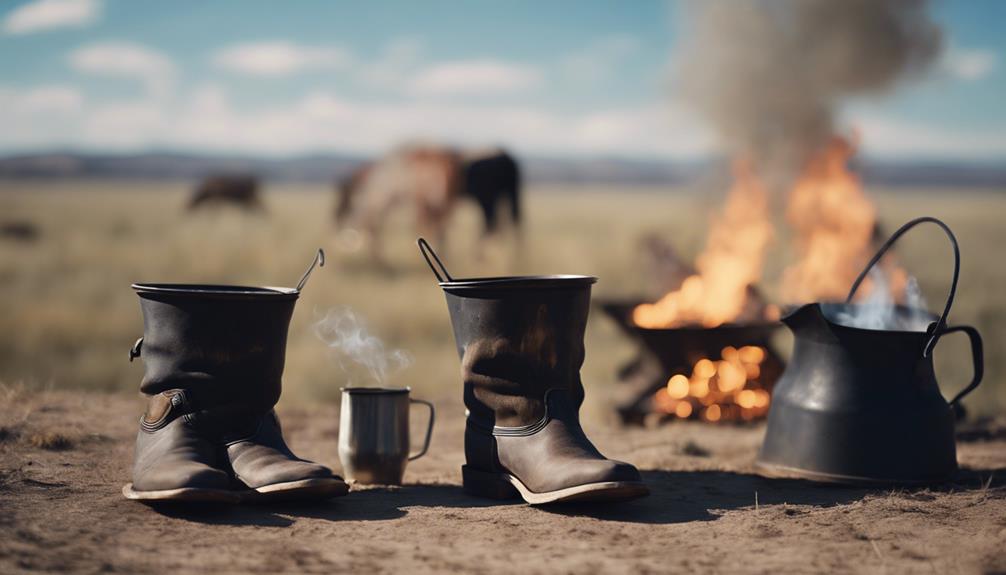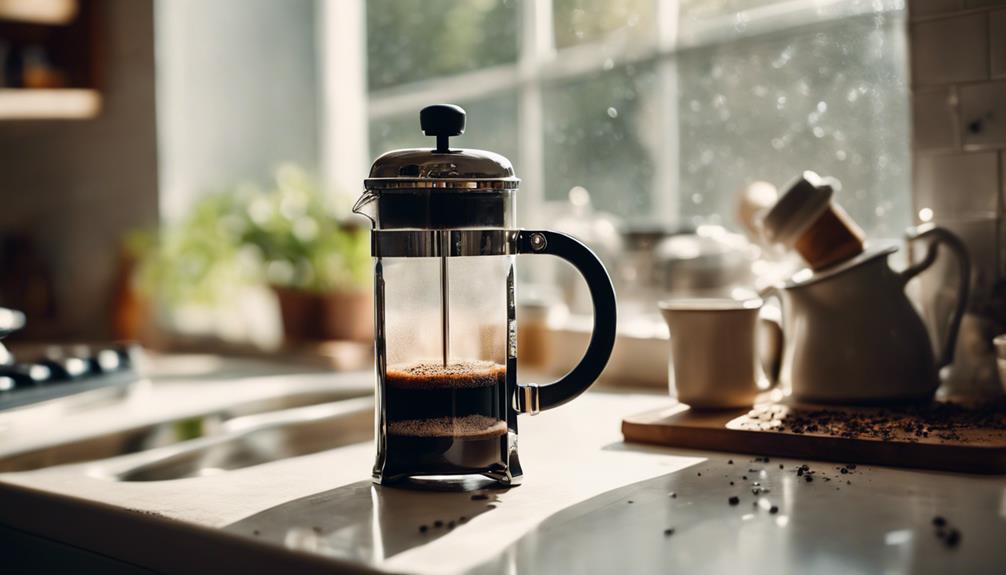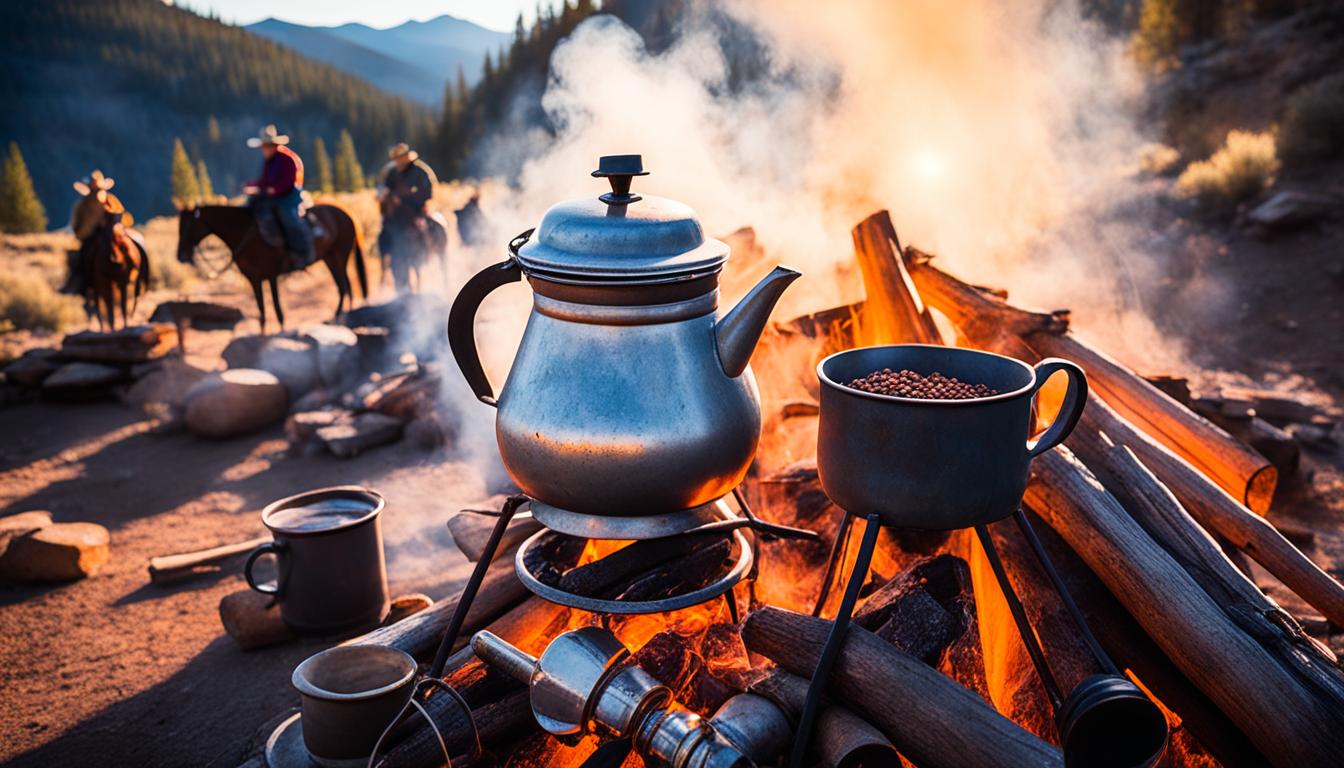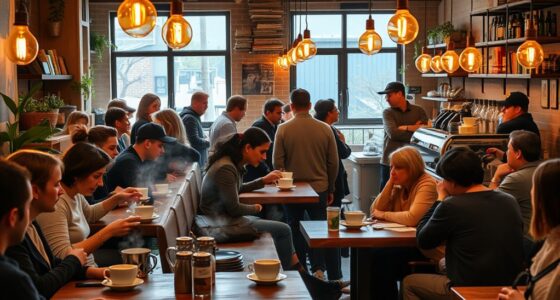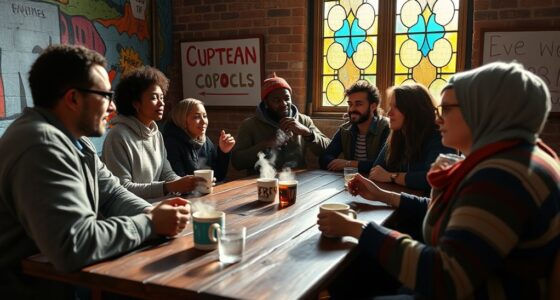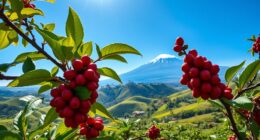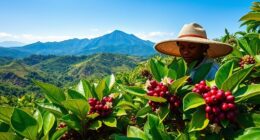In the 1800s, cowboys brewed coffee by boiling coarse-ground beans in a tin pot over an open campfire, typically adding a pinch of salt to enhance flavor and reduce bitterness. They didn’t use filters; instead, they let the grounds settle at the bottom. Sometimes, crushed eggshells were added to reduce acidity and help settle the grounds more effectively. Cowboys showcased their resourcefulness by reusing old coffee grounds, adding fresh ones to maintain a robust brew. This method, known for its strong, smoky flavor, reflects the ingenuity and adaptability of cowboys. To discover more intriguing details, you can continue your exploration.
Key Takeaways
- Cowboys boiled water over an open fire and added coarse-ground coffee directly without filters.
- They used tinned iron pots to steep the coffee, enhancing the flavor with the campfire's smokiness.
- A pinch of salt was added to enhance the flavor and reduce bitterness.
- Crushed eggshells were used to reduce acidity and help settle the coffee grounds.
- Reusing spent coffee grounds by adding fresh grounds maintained a robust flavor and showcased cowboy ingenuity.
Historical Context
In the 1800s, cowboys relied on strong, black coffee brewed over an open fire to fuel their grueling days on the trail. The daily life of a cowboy during this era was demanding, with long hours spent herding cattle across vast landscapes. To keep their energy levels high, cowboys turned to a simple yet effective method of brewing coffee, known as 'cowboy coffee.'
Historical accounts from the 1800s consistently highlight the significance of coffee in cowboy culture. Cowboys used tinned iron pots to boil water over an open fire, combining it with coffee grounds to create a robust, energizing beverage. This method was practical and efficient, allowing them to make coffee with minimal equipment and in various outdoor settings.
The choice of strong, black coffee wasn't just about taste—cowboys needed a potent drink to help them stay alert and focused during their arduous journeys. The simplicity of cowboy coffee brewing, using just water and coffee grounds, reflects the resourcefulness and resilience of these trailblazers. Understanding this historical context provides insight into the daily routines and survival strategies of cowboys in the 1800s, emphasizing the vital role that coffee played in their lives.
Essential Ingredients
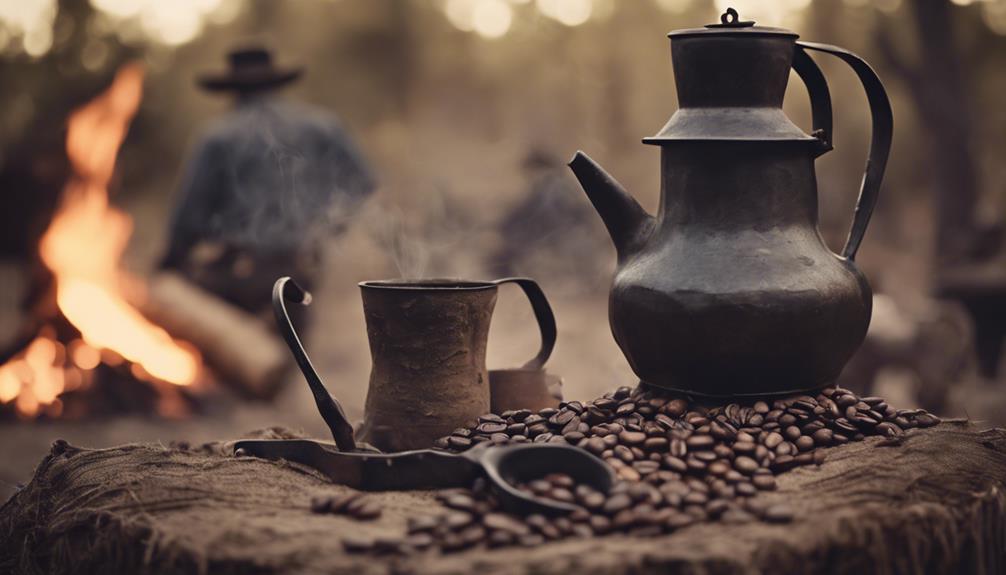
To brew authentic cowboy coffee, you'll need just a few essential ingredients: water, coarse-ground coffee beans, and occasionally a pinch of salt. The importance of these ingredients made cowboy coffee easy to make, even under the challenging conditions of the open range. Cowboys typically used water as their base, which was often collected from nearby streams or carried in canteens.
The coffee beans were usually roasted and ground on-site to guarantee freshness, which was vital for producing a strong coffee. Coarse grounds were preferred because they were less likely to become over-extracted during brewing, resulting in a robust and flavorful cup. This method also allowed for easy separation of the grounds from the liquid, making the coffee more palatable.
Adding a pinch of salt wasn't always necessary, but it was a common practice among cowboys to enhance the flavor and reduce the bitterness of the coffee. This simple combination of roasted beans, water, and sometimes salt, created a potent and energizing beverage that was essential for fueling long days of hard labor. By relying on these basic ingredients, cowboys could consistently brew the strong, flavorful cowboy coffee that became a staple of their daily routine.
Brewing Method
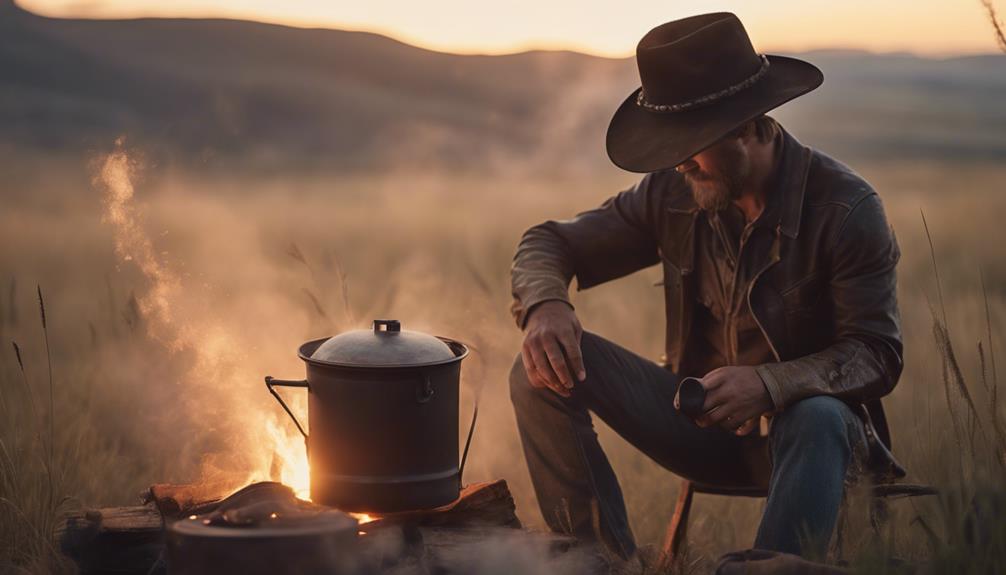
When making cowboy coffee, you'd start by boiling water in a large pot over an open fire or hot coals and then add coarse coffee grounds directly into the water. Essential campfire brewing tools included the pot, often referred to as a coffee boiler or cowboy coffee pot, and a sturdy heat source.
Unlike modern methods, cowboys didn't use filters, so the grounds would naturally settle at the bottom, resulting in a strong, unfiltered brew.
Cowboy Coffee Recipe
Cowboys in the 1800s brewed their coffee by boiling water in a pot and adding coarse ground coffee directly into it. This method of making cowboy coffee was straightforward and practical, fitting the rugged lifestyle of cowboys on the trail.
You'd start by placing a pot of water over an open fire until it reached a rolling boil. Once the water was boiling, you'd add a generous amount of coarse coffee grounds into the pot. The boiling process helped extract the coffee's flavors, resulting in a strong and robust brew that was both invigorating and satisfying.
To guarantee the grounds settled at the bottom of the pot, cowboys often employed a clever trick. They'd add a small amount of cold water or even crushed eggshells to the pot after removing it from the fire. This would cause the coffee grounds to sink, allowing you to pour a relatively clear cup of coffee.
This method, though lacking modern conveniences like filters, was highly effective and produced a hearty beverage that met the needs of hardworking cowboys. The simplicity of this brewing method reflects the resourcefulness and resilience of the cowboy lifestyle.
Campfire Brewing Tools
Large tinned iron pots were essential tools for brewing coffee over a campfire, their sturdy construction perfect for the rugged conditions of the trail. When making Cowboy Coffee, you'd start by filling the pot with water and placing it over an open flame.
As the water heated, you'd add ground roasted coffee beans directly into the pot. Once the water reached a boil, it often overflowed, ensuring the coffee grounds were thoroughly mixed. This method of brewing didn't use filters, allowing the grounds to sink to the bottom of the pot.
To give you a clearer picture of the tools and process:
- Large tinned iron pots: Durable and suited for campfire heat.
- Ground roasted coffee beans: Added directly to boiling water.
- Open flame: Essential for heating water to a boil.
- No filters: Grounds settled naturally at the bottom of the pot.
- Blackened pots: The smoke added unique flavors to the coffee.
This method of brewing was a daily ritual, ensuring that cowboys had the energy needed for their demanding work. The simplicity and effectiveness of this technique made it a staple in cowboy life, reflecting their resourcefulness and adaptability.
Campfire Setup
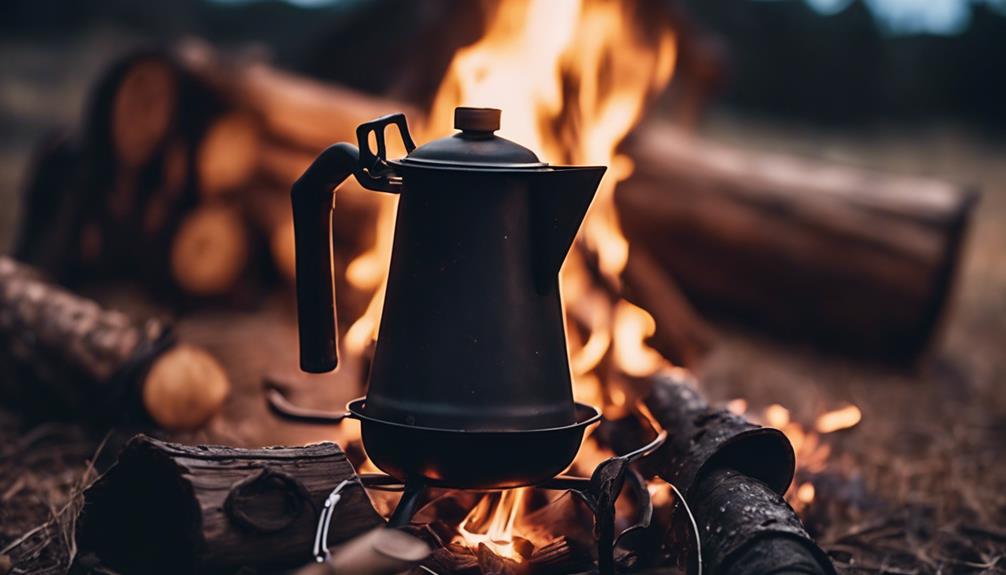
Before brewing their coffee, cowboys would set up a campfire with hot coals or an open flame to generate the necessary heat. This campfire setup was vital for making coffee, commonly known as cowboy coffee. To start, they'd gather dry wood and kindling to create a dependable flame. Once the fire was established, they'd let it burn down to hot coals or maintain a steady flame, guaranteeing consistent heat for boiling water.
Cowboys used tinned iron pots, blackened by smoke, as their primary brewing vessels. These pots were perfect for holding the boiling water and steeping ground coffee beans. The robust flavor of cowboy coffee was a result of this unique campfire brewing method. The hot coals or open flame provided the high temperatures needed to bring the water to a boil, essential for extracting the strong flavors from the ground coffee beans.
| Step | Description | Purpose |
|---|---|---|
| Gather Wood | Collect dry wood and kindling | To create a dependable flame |
| Start Fire | Ignite the wood to establish a fire | To generate heat for boiling water |
| Maintain Heat | Let fire burn to hot coals or steady flame | Ensure consistent heat for brewing |
| Use Iron Pot | Place tinned iron pot on fire | For boiling water and steeping coffee |
The campfire setup provided the essential heat needed to produce piping hot and robust cowboy coffee, a daily ritual for cowboys on the trail.
Eggshell Trick

In the 1800s, adding crushed eggshells to coffee was a demonstration of the ingenuity of cowboys to reduce acidity and bitterness. Cowboys relied on this method to improve their 'cowboy coffee,' making it smoother and more palatable. The process was straightforward and practical, especially for those on the trail.
By incorporating crushed eggshells into the brewing process, cowboys achieved several benefits:
- Reduced acidity: The calcium in the eggshells neutralized some of the coffee's natural acids.
- Less bitterness: The eggshells helped mellow out the harsh, bitter notes often found in poorly roasted or over-extracted coffee.
- Natural filter: The eggshells acted like a filter, aiding in the settling of coffee grounds at the bottom of the pot.
- Enhanced flavor: The resulting brew was smoother and more flavorful, making it more enjoyable.
- Simple preparation: Mixing crushed eggshells with the coffee grounds before brewing was an easy and effective method.
This eggshell trick was a demonstration of the resourcefulness of cowboys who'd to make do with limited resources. By using eggshells, they transformed their coffee experience, creating a brew that wasn't only drinkable but also quite enjoyable.
Reusing Grounds

Cowboys in the 1800s didn't let anything go to waste, often reusing coffee grounds to maximize flavor and strength. Reusing grounds was a practical way to guarantee a good cup of coffee during long days on the range. Known as cowboy coffee, this method involved making coffee without a filter, allowing cowboys to make the most of their limited resources. By adding fresh coffee on top of spent grounds, cooks on the trail could recycle and enhance the potency of their brew. This practice helped maintain a robust coffee flavor throughout their travels, making sure that coffee grounds stayed useful for multiple brews.
When you make cowboy coffee, you're engaging in a tradition that values resourcefulness. The process of reusing grounds was commonplace and necessary, given the scarcity of supplies on the trail. By doing so, cowboys could extend the life of their coffee stash, making sure they always had a strong and flavorful drink. This approach not only conserved precious resources but also delivered a consistently good cup of coffee, even in the rugged conditions of the Old West.
Reusing grounds became an essential part of cowboy coffee culture, reflecting their ingenuity and adaptability.
Flavor Profile

Reusing coffee grounds not only conserved resources but also contributed to the distinct, bold flavor profile that cowboys favored. When you think about the coffee cowboys drank, imagine it as strong and black, brewed over an open fire. The flavor profile was deeply influenced by the unique brewing methods they employed and the environment in which the coffee was made.
Cowboys would often roast and grind the coffee beans on-site, ensuring that the coffee had a fresh, earthy taste. The absence of filters allowed the full flavor and oils from the grounds to remain in the brew, giving it a richer, more robust taste. Additionally, the wood smoke from the open fire where the coffee was brewed imparted a smoky undertone that enhanced the overall experience.
Here are some key flavor elements:
- Bold and robust taste
- Strong, black coffee profile
- Earthy and fresh, from recently roasted beans
- Smoky undertone from the open fire
- Unfiltered richness, with full coffee oils
These elements combined to make a cup of coffee that wasn't only invigorating but also a true reflection of the rugged life of a cowboy. The simplicity of their brewing methods brought out a strong and authentic flavor profile that remains iconic today.
Tools and Equipment
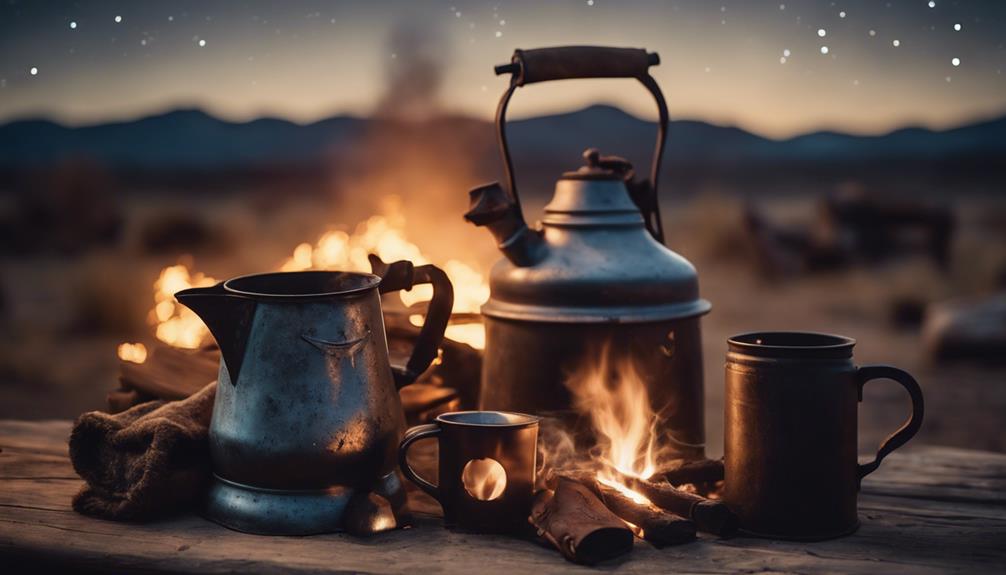
When making coffee in the 1800s, cowboys relied on large, durable pots typically made of tinned iron, which were blackened by the smoke from open fires.
These pots were essential tools, allowing cowboys to brew coffee over an open flame or hot coals with ease.
The simplicity and practicality of these pots made them indispensable in the rugged conditions of the American frontier.
Basic Coffee Tools
In the 1800s, brewing coffee on the trail required just a few basic tools: a large tinned iron pot, water, and coffee grounds. Cowboys kept it simple and practical, making do with minimal equipment to brew their much-needed morning coffee.
Here's what you'd typically need:
- Large tinned iron pot
- Water
- Coffee grounds
- Cup
- Cup cold water
To start making your coffee, you'd first need to measure the coffee to water ratio. Cowboys generally didn't have precise measuring tools, so they relied on experience and rough estimations. Typically, they'd add coffee grounds directly to the pot of boiling water. Once the grounds were in, they'd let it sit and steep for several minutes.
After the coffee had steeped, a cup of cold water was often added to help the grounds settle at the bottom of the pot. This step made it easier to pour the coffee without getting too many grounds in the cup.
The final step was to pour the coffee carefully into your cup, enjoying a robust brew that was a staple on the trail.
Cooking Over Fire
Cooking over an open fire required cowboys to master the use of simple yet durable tools like large tinned iron pots and cast-iron skillets. These pots, often blackened by smoke, were essential for brewing coffee that could serve the entire camp. The open fire provided the necessary heat to boil water, which was vital for extracting the rich flavors from the coffee grounds. Cowboys would let the water reach a rolling boil before adding the coffee grounds, ensuring a robust brew.
Brewing coffee over an open fire became a communal activity among cowboys after a long day's work. The simplicity of the process, relying on basic yet sturdy equipment, added to the rugged charm of cowboy life in the 1800s. Large tinned iron pots, with their capacity to hold significant quantities, were particularly favored for this task. The cowboys' ability to brew coffee using minimal tools exemplifies their resourcefulness and adaptability.
Modern Adaptations
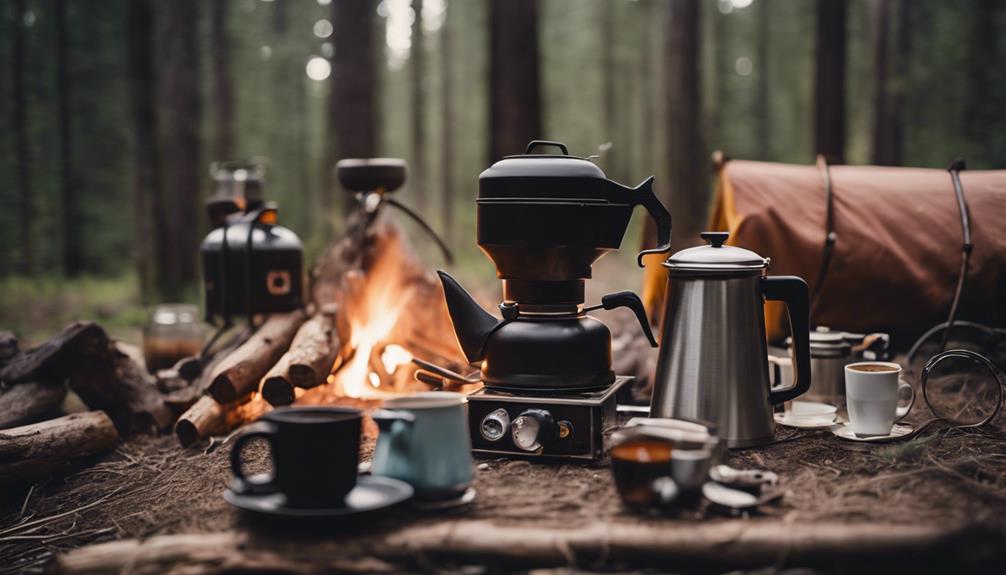
Today's coffee enthusiasts have found creative ways to adapt the rugged simplicity of traditional cowboy coffee to modern tastes and conveniences. If you want to enjoy the essence of cowboy coffee without the sediment, you can use a French press coffee maker for a cleaner brew. This method combines the robust flavor of cowboy coffee with the refinement of modern coffee techniques.
For a more makeshift coffee experience, some people even use a clean sock as a filter to capture the coffee grounds. Modern adaptations have also introduced instant coffee granules, making it quicker and more convenient to prepare a cup of cowboy coffee. Specialty coffee shops sometimes offer a 'cowboy coffee' menu item, inspired by the traditional method but tailored to modern palates.
If you're into outdoor adventures, instant cowboy coffee packets are perfect for camping trips, combining ease of use with the nostalgic charm of the original brew.
French press coffee without sediment
Instant coffee for quick preparation
Clean sock as a makeshift filter
Specialty coffee shops' cowboy coffee
Instant cowboy coffee packets for camping
These adaptations allow you to enjoy the rustic charm of cowboy coffee with the convenience of modern coffee-making techniques.
Frequently Asked Questions
How Was Cowboy Coffee Made?
Cowboy coffee was made by boiling water in a tinned iron pot over an open fire or hot coals.
Ground roasted coffee beans were added directly to the pot without following a specific coffee-to-water ratio.
The mixture was boiled until it overflowed and became piping hot.
This rustic method resulted in a robust flavor, allowing cowboys to enjoy a hot, energizing beverage while on the trail.
How Did People in the 1800S Make Coffee?
Imagine using a Keurig back then—people in the 1800s made coffee quite differently. They boiled water with coarse coffee grounds in a pot over an open fire, often roasting and grinding the beans on-site.
After boiling, they'd let the grounds settle to avoid transferring them to the cup. This method resulted in a strong, black coffee that provided essential warmth and energy during their day.
What's the Secret Ingredient in Cowboy Coffee?
The secret ingredient in cowboy coffee is salt. By adding a pinch of salt, you enhance the flavor and reduce the bitterness of the coffee, creating a smoother and richer taste.
This practice, rooted in tradition, balances the acidity and improves the overall quality of the brew. Salt acts as a flavor enhancer, adding depth to the coffee's profile, a method cowboys used to elevate their daily cup.
What Did the Pioneers Use to Make Coffee?
Imagine pioneers as alchemists, turning simple ingredients into liquid gold. They used tinned iron pots over open fires or hot coals to make coffee.
Ground roasted coffee beans were added to water, then boiled until piping hot. They often let it overflow, ensuring a strong brew.
Unlike modern methods, they didn't worry about precise ratios, focusing instead on creating a robust, energizing drink to fuel their journeys.
Were Coffee-making Methods in the 1800s Similar to the Bean Origins of Famous Italian Coffee Brands?
Yes, the coffee-making methods in the 1800s were similar to the famous Italian coffee brand origins. Italian coffee brands like Lavazza and Illy were founded during this time and their coffee-making techniques were heavily influenced by the traditional methods of roasting and brewing.
What methods and tools did cowboys use to make coffee in the 1800s?
In the 1800s, cowboys brewed coffee over an open campfire using a simple pot or a tin can. They would grind coffee beans by hand using a mortar and pestle, then boil the grounds with water. This method of how cowboys brewed coffee created a strong, satisfying cup of joe to fuel their long days on the trail.
Conclusion
To sum up, understanding how cowboys made coffee in the 1800s provides a fascinating glimpse into their resourcefulness and adaptability.
While modern coffee-making methods have evolved greatly, the basic principles—such as using simple ingredients, brewing over a campfire, and even employing techniques like the eggshell trick—highlight the ingenuity of these early pioneers.
By juxtaposing historical practices with contemporary methods, you can appreciate both the continuity and change in our coffee culture.
